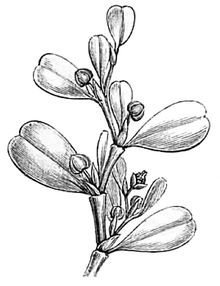| Lactoris | |
|---|---|

| |
| Scientific classification | |
| Kingdom: | Plantae |
| Clade: | Tracheophytes |
| Clade: | Angiosperms |
| Clade: | Magnoliids |
| Order: | Piperales |
| Family: | Aristolochiaceae |
| Genus: | Lactoris Phil.[1] |
| Species: | L. fernandeziana
|
| Binomial name | |
| Lactoris fernandeziana Phil.
| |
Lactoris fernandeziana is a flowering shrub endemic to the cloud forest of Masatierra — Robinson Crusoe Island, of the Juan Fernández Islands archipelago of Chile. It is the only extant species in the genus Lactoris.[1]
YouTube Encyclopedic
-
1/3Views:75 5327 185565
-
The Cori cycle
-
Tirmit mantarı sütlü tirmit tanımı ve yapılışı ( Lactarius volemus )
-
MRCS Interactive MiniSession ColoRectal 1
Transcription
Taxonomy
The species is now included in Aristolochiaceae following APG IV (2016).[2]
Morphological data are not clear concerning the classification of Lactoris,[3] but molecular data place it in the Aristolochiaceae.[4]
In the fossil record, pollen has been found which seems to be related to the living Lactoris species.[5]
Habitat and conservation
Lactoris fernandeziana seems to be wind-pollinated. The wild population of about 1000 plants has low genetic diversity, and grows on foggy and rainy slopes, usually as an understory plant but sometimes in full sun.
Cultivation of seedlings has generally been unsuccessful, although cuttings have worked better and better knowledge of preferred growing conditions may make cultivation easier.[5]
See also

References
- ^ a b "Lactoris Phil". Plants of the World Online. Royal Botanic Gardens, Kew. Retrieved 2021-08-25.
- ^ Angiosperm Phylogeny Group (2016), "An update of the Angiosperm Phylogeny Group classification for the orders and families of flowering plants: APG IV", Botanical Journal of the Linnean Society, 161 (2): 105–20, doi:10.1111/boj.12385
- ^ Favio González; Paula Rudall (2001). "The questionable affinities of Lactoris: evidence from branching pattern, inflorescence morphology, and stipule development". American Journal of Botany. 88 (12): 2143–2150. doi:10.2307/3558375. JSTOR 3558375. PMID 21669646.
- ^ Daniel L. Nickrent; Albert Blarer; Yin-Long Qiu; Douglas E. Soltis; Pamela S. Soltis & Michael Zanis (2002). "Molecular data place Hydnoraceae with Aristolochiaceae". American Journal of Botany. 89 (11): 1809–1817. doi:10.3732/ajb.89.11.1809. PMID 21665609.
- ^ a b Gabriel Bernardello; Gregory J. Anderson; Patricio Lopez S.; Maryke A. Cleland; Tod F. Stuessy; Daniel J. Crawford (1999). "Reproductive biology of Lactoris fernandeziana (Lactoridaceae)". American Journal of Botany. 86 (6): 829–840. doi:10.2307/2656704. JSTOR 2656704. PMID 10371725.
 Media related to Lactoris fernandeziana at Wikimedia Commons
Media related to Lactoris fernandeziana at Wikimedia Commons
